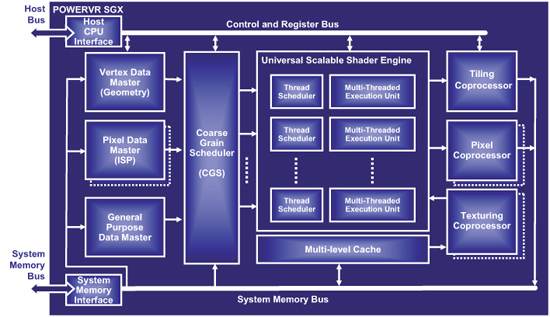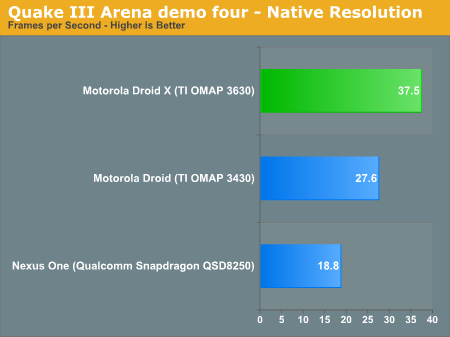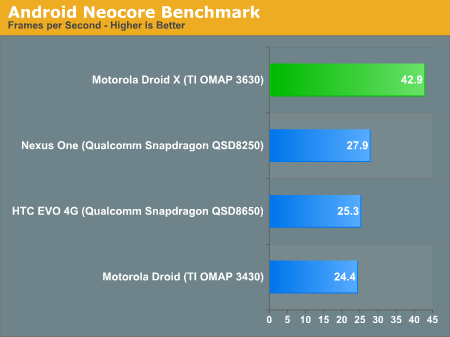Motorola Droid X: Thoroughly Reviewed
by Brian Klug on July 20, 2010 4:27 PM EST- Posted in
- Smartphones
- Motorola Droid X
- OMAP
- Mobile
The OMAP GPU - Powered by Imagination Technologies
TI continues to license its GPUs from Imagination Technologies. Rather than move to the PowerVR SGX 535 used by Apple and Intel, TI stuck with the same PowerVR SGX 530 core used in the OMAP 3430. The difference between the SGX 530 and 535 is as follows.
ImgTec refers to the execution hardware in its Series 5 GPUs as a Universal Scalable Shader Engine (USSE). Each USSE pipe can execute a 2-wide vector or up to a 4-way SIMD scalar op in a single clock. Both the SGX 530 and 535 have two USSE pipes from what I can tell.

The SGX 535 used in Apple’s A4 and Intel’s Atom Z600 series apparently have a second texturing unit and DirectX 9L support.
We’d expect that 3D apps on smartphones are more compute bound these days so it’s difficult to say how much you lose by going with the SGX 530 vs. 535. Until we get a Moorestown dev kit running Android we won’t be able to shed much light on that.
While the OMAP 3430 ran the GPU core at ~110MHz, the 3630 ramps it up to 200MHz. We’re seeing a lot of convergence around this 200MHz mark at 45nm. Intel runs the SGX 535 in Moorestown (Atom Z600 series) at 200MHz as well and I believe that’s what Apple uses in the A4 as well.
The 80% increase in GPU clock speed should result in significant real world GPU performance improvements. Just as with the CPU, there are no significant architectural changes to the GPU - it just runs faster.
The memory controller is still a 32-bit LPDDR1 interface, but can now run at up to 200MHz (the 3430 was limited to 166MHz). Should a customer choose to go for 200MHz LPDDR1 you’d get a 20% increase in memory bandwidth which will come in handy with the faster GPU in 3D apps for sure.
The GPU Performance Showdown: Snapdragon vs. OMAP 3630
When Brian first started cranking on the Droid X review he wanted to put the Qualcomm Adreno 200 vs. PowerVR SGX debate to rest. We had always reported that Qualcomm’s Snapdragon GPU was slower than the PowerVR SGX used in Apple’s A4 and TI’s OMAP 3, but we didn’t have a good idea of how much slower. Until now that is.
Armed with the Google Nexus One (Snapdragon QSD8250), Motorola Droid (OMAP 3430) and Motorola Droid X (OMAP 3630) all running Android 2.x (the N1 was running 2.2) we polished off one of the most popular GPU benchmarks of our time: Quake III Arena.
The kwaak3 project ported Q3A from a Nokia N900 version to Android. With a bit of elbow grease and getting around the lack of touchscreen keyboard support, we got the benchmark running. All scores were generated at default graphics quality settings and at native resolution, which unfortunately means the Droid X has around 7% more pixels to render than the other Android devices.

Even with the handicap, the 200MHz PowerVR SGX 530 core manages double the frame rate of the Adreno 200 in the Nexus One’s Snapdragon. Even the 110MHz SGX 530 is faster.
Here’s another interesting tidbit - we’re actually CPU bound on all of these platforms running demo four in Q3A:

Droid X (OMAP 3630) CPU utilization while running Quake III Arena
Intel is talking about greater than 100 fps frame rates with Atom Z600, meaning that the advantage is strictly on the CPU side. This also tells us that the PowerVR SGX 530 may even be a good fit for next year’s Cortex A9 based SoCs, even though TI has already committed to using the SGX 540 in its OMAP 4 line.
Neocore is another popular GPU benchmark, although this one is written for Qualcomm’s Adreno 200. The OpenGL ES 1.1 benchmark is mostly a GPU test but also stresses the platform as a whole. Running on our OMAP 3 based phones we see an average of 50% CPU utilization during the test.

The Droid X (OMAP 3630) CPU utilization while running Neocore
Interestingly enough, running the same test on a Snapdragon platform shows higher CPU utilization:

The Nexus One (Snapdragon) CPU utilization while running Neocore
The benchmark could be very well optimized for Qualcomm’s Scorpion core resulting in better CPU utilization compared to a Cortex A8.

The Adreno 200 in the Nexus One and EVO 4G outperforms the PowerVR SGX in the original Droid by 4 - 14%. This isn’t a surprise given the Qualcomm branding on the benchmark. The 45nm SGX 530 running at 200MHz puts all question to rest, the OMAP 3630 is 53% faster than Snapdragon.
The comparison here is obviously more than just GPU to GPU. We’re dealing with different CPU cores (ARM Cortex A8 vs. Qualcomm Scorpion), different memory controllers, different caches, and different drivers. Just as we’ve seen in the desktop GPU race, driver and benchmark optimizations have a lot to do with 3D performance results. I put more faith in the Quake 3 results, however those too came from a port optimized for PowerVR’s SGX.










89 Comments
View All Comments
homebredcorgi - Tuesday, July 20, 2010 - link
Who do we have to blame for the “Droid” moniker? Verizon or Motorola?I have a Nexus One and continually get asked, “Is that a Droid?” or “Does that run Droid?” to which I usually reply yes and let sleeping dogs lie…but seriously, why name it so similar to the operating system? And then why make “Droid” a series of phones if your first phone is just known simply as “Droid”?! At least call it the "Droid One" or something to differentiate from the series of phones....
So now we have the Droid, Droid Eris, Droid X, and will soon have the Droid 2 which are all phones in the Droid series, all running on various builds of Android. Yeesh. Could they have made that any more confusing?
All in all, the Droid X looks very nice. I personally think the original Droid had all the flair of a TI-82 calculator (ugly as sin in a blocky retro way), but the Droid X seems to have modernized its looks. Still not sure if I would want a phone that large though….
metafor - Tuesday, July 20, 2010 - link
Verizon owns the rights to the "Droid" trademark from Star Wars. So they decided to capitalize on that and name their whole line of Android phones "Droids".I think it's kinda cheezy but hey, it's selling and is something that people can focus on. With the army of phones coming out every week, it's difficult for the average person to keep up. It helps if they can just go to a store and ask for a Droid.
strikeback03 - Tuesday, July 27, 2010 - link
Actually they have only been using Droid on the high-end phones, the Devour and Ally were not Droids.There is also rumor of a special edition Droid 2 coming with R2-D2 on the battery cover...
lewchenko74 - Tuesday, July 20, 2010 - link
The best, most comprehensive review of the Droid X Ive read so far. Thank you.Just got to wait until it arrives in the UK unlocked now, but personally I think Im going to get the Droid 2 instead with the keyboard.
I am amazed at the pace the smartphone market is moving at. Im 1yr into a 2yr contract with a HTC Hero. It feels like an antique! These 2yr contracts really are a ball and chain.
It also seems like HTC is starting to lag behind Samsung and Moto now in terms of processor and features. Sense also seems a little 'old' compared to other UI layers (or maybe thats just me).
Disappointed that it only runs Android 2.1 when 2.2 is now out though.... That would be like Apple releasing iPhone4 running OS3.2 whilst saying OS4 is out there too but not quite available yet! (I guess Apple actually did that though with the iPad ;-) )
mvmorr01 - Tuesday, July 20, 2010 - link
What app are you using for those CPU utilization graphs? I did a quick search and couldn't find it in the market.Brian Klug - Tuesday, July 20, 2010 - link
It's an application called "SystemPanel" which I found a while back. If you turn logging on, it'll give you some very cool graphs of battery use over time and CPU utilization over days even. Produces some very cool results when I do battery life testing.-Brian
529th - Tuesday, July 20, 2010 - link
First of all I want to say I love mine! :) Bought it the day it came out.Wow what a great review!!!
I didn't know you could run benchmarks on a phone! Linpack!?? WOW awesome!
I can't wait till Froyo! :)
Thanks again chief!
<3 Anandtech reviews!
WaltFrench - Saturday, July 24, 2010 - link
Linpack is a 90s-era benchmark that performs a specific matrix solution. As much as possible, all floating point adds and muls.I've tried in other forums to find an app, prior to 6/1/2010, that actually uses Gaussian elimination with partial pivoting. The particular method works best to find complex patterns within large data sets; that's great for my statistical investment models and for a lot of other stuff. It's strongly suggestive of performance on weather simulations, quantum chemistry, etc., stuff that no sane person would attempt (today) on a smartphone.
Others claim Linpack scores around 40 on overclocked ARM chips with Froyo (the JITting being fabulously helpful for highly repetitive benchmark code). I got ~35 on my iPhone. These scores are ~ 13X–16X what the Linpack author quoted long ago for his 486 (/487, I presume).
I don't know a lot about graphics but presume 3D work that calls for lots of floating point Add/Mul work would get routed to the GPU, so I think these scores are of extremely limited relevance to any smartphone app I can envision.
vshin - Tuesday, July 20, 2010 - link
Where are the antenna attenuation tests? No weak spots?Brian Klug - Tuesday, July 20, 2010 - link
There's definitely attenuation tests in there, and weak spots. The bottom of the phone as expected causes a 15 dB drop. It's on page 14: http://www.anandtech.com/show/3826/motorola-droid-...-Brian